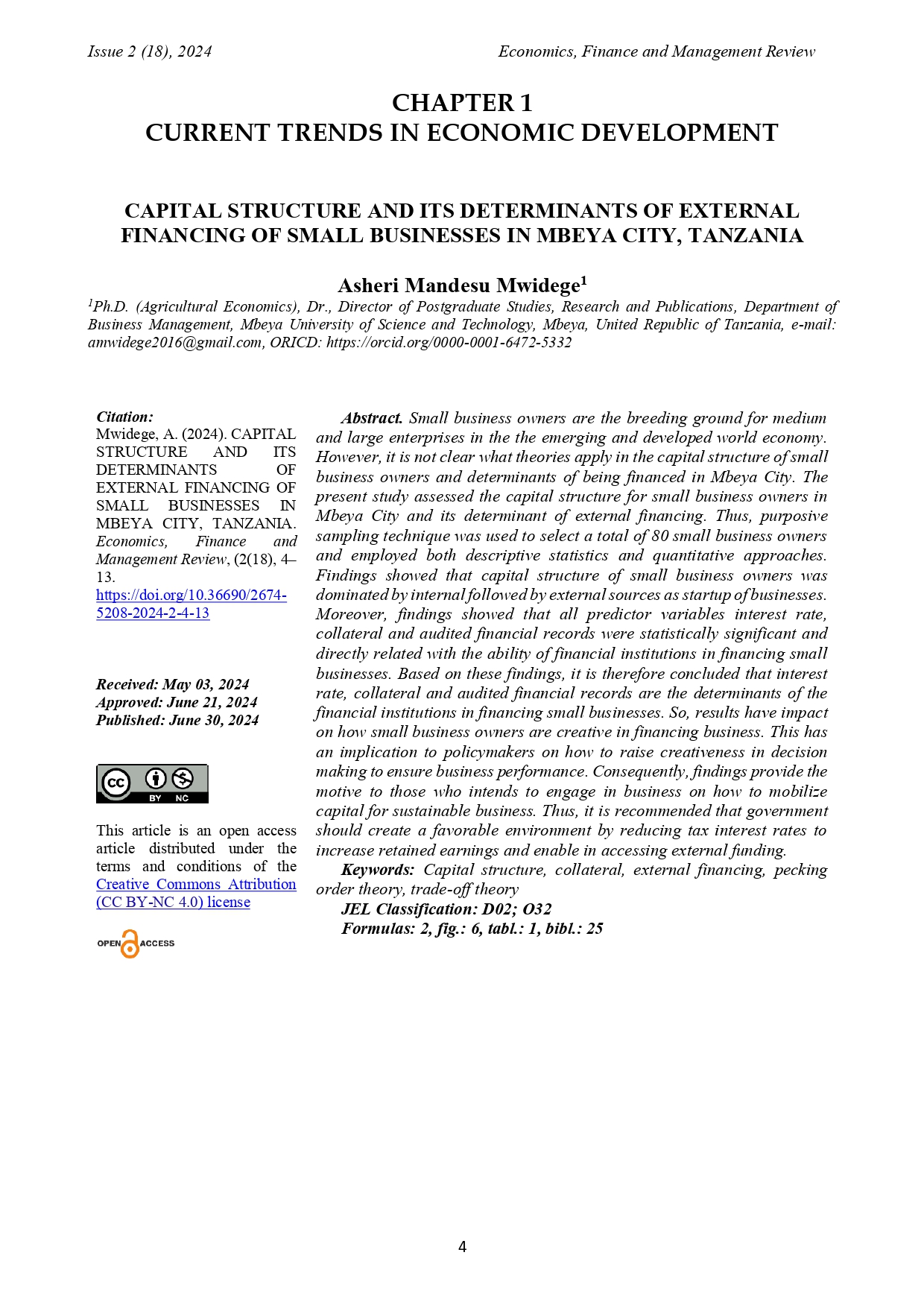CAPITAL STRUCTURE AND ITS DETERMINANTS OF EXTERNAL FINANCING OF SMALL BUSINESSES IN MBEYA CITY, TANZANIA
DOI:
https://doi.org/10.36690/2674-5208-2024-2-4-13Keywords:
capital structure, collateral, external financing, pecking order theory, trade-off theoryAbstract
Small business owners are the breeding ground for medium and large enterprises in the the emerging and developed world economy. However, it is not clear what theories apply in the capital structure of small business owners and determinants of being financed in Mbeya City. The present study assessed the capital structure for small business owners in Mbeya City and its determinant of external financing. Thus, purposive sampling technique was used to select a total of 80 small business owners and employed both descriptive statistics and quantitative approaches. Findings showed that capital structure of small business owners was dominated by internal followed by external sources as startup of businesses. Moreover, findings showed that all predictor variables interest rate, collateral and audited financial records were statistically significant and directly related with the ability of financial institutions in financing small businesses. Based on these findings, it is therefore concluded that interest rate, collateral and audited financial records are the determinants of the financial institutions in financing small businesses. So, results have impact on how small business owners are creative in financing business. This has an implication to policymakers on how to raise creativeness in decision making to ensure business performance. Consequently, findings provide the motive to those who intends to engage in business on how to mobilize capital for sustainable business. Thus, it is recommended that government should create a favorable environment by reducing tax interest rates to increase retained earnings and enable in accessing external funding.
Downloads
References
Abdullah, H. and Tursoy, T. (2021) Capital Structure and Firm Performance: Evidence of Germany under IFRS Adoption. Review of Managerial Science 15(1) 379-398
Achmad, S. (2021). The pattern of Relationship between Macro-Economics, Capital Structure, Profitability and Firm Value of Manufacturing Companies. International Journal of Business Marketing and Management. 6(1), 70-80.
Aswath, T., A. Demirgüç-Kunt, L. Merton, and V. Maksimovic, (2020). “The Determinants of Financing Obstacles”, Journal of International Money and Finance 25, 932–952,
Berisha, A., Hoti, A., and Hoti, H. (2023). An empirical study on micro, small, and medium enterprises access to finance in Kosovo: A survey based analysis.Multidisciplinary Science Journal, 6(5). https://malquepub.com/index.php/multiscience/article/view/191.
Chen G, Pan W, Kainz K (2021) Journal of the Society for Social Work and Research 12(2) 421-436
David, P. Jonathan, O. and Delios, A. (2021). The Influencing Power of Apply and Explain on Capital Structure. Strategic Management Journal 35 (7), 1013-103
Dung, D. and Ngan, C. (2024). Factors influencing Small and Medium Enterprises’ decision to Apply for Bank Loans: A Quantitative Analysis In Vietnam. Economics, Finance and Management Review, (1(17), 78–87. https://doi.org/10.36690/2674- 5208-2024-1-78.
Eckbo, S. Kisser, T. (2021) The Leverage-Profitability Puzzle Resurrected. Review of Finance25 (4), 1089-1128.
Ismail, A. and Sinha, K. (2024). Access to Financing and the Success of Small and Medium-Scale Enterprises: A Case of Wa Municipality in Ghana. Educational Administration:Theory and Practice, 30(4), 2593–2603. https://doi.org/10.53555/kuey.v30i4.1900
Jahanzeb, A., Ur-Rehman, S., Bajuri, N.H., Karami, M., and Ahmadimousaabad, A. (2013). Trade-Off Theory, Pecking Order Theory and Market Timing Theory: A Comprehensive Review of Capital Structure Theories. International Journal of Management and Commerce Innovations (IJMCI). 1(1): 11-18.
Jew, M. Remus, S. and Claudia, D. (2019). Capital Structure and Corporate Performance in Late Imperial Russia. Journal of Finance Management 25(4)
Jrad, M. (2023). Assessment of Lebanese SME Troubles- Barriers to Banking Loan: Indebtedness Study for Lebanese SMEs. Review of Economics and Finance, 21(1):2392-2403.
Jumanne, S.Sokoni, C. andMakawa, E. (2021). Factors Influencing Farmers to Convert Productive Croplands into Woodlots in Mbeya Rural District Tanzania.Journal of the Geographical Association of Tanzania 41 (1)
Kibler, E. Mandly, C. Farny, S. (2021). Collective Intentionality in Entrepreneurship as PracticeHuman Relation 74(2) 286-318
Kofi, O. (2021). The Relationship Between Capital Structure Practices and Financial Distress in West Africa. Research Journal of Finance and Accounting 4 (17) 213-219.
Krasniqi,B., Kotorri, M., and Aliu, F. (2023). Relationship Banking, Collateral, and the Economic Crisis as Determinants of Credit Risk: An Empirical Investigation of SMEs. South East European Journal of Economics and Business, 18 (2) 2023, 49-62 DOI: 10.2478/jeb-2023-0018.
Leavy, B. (2017). Outsourcing Strategies, Opportunities and Risks. Journal of Strategy and Leadership 49(1) 141-150.
Lemmon, M.L. and Zender, J.F. (2010). Debt Capacity and Tests of Capital Structure Theories. Journal-of-financial-and-quantitative-analysis. 45(5): 1161-1187. https://doi.org/10.1017/S0022109010000499
Lwidiko, B. andIshengoma, E. (2021). Access to Debt Finance and Performance of Small and Medium Enterprises.Financial Journal of Risk Management 10 (3), 241-259.
Mostafa, H.T. and Boregowda, S. (2014). A Brief Review of Capital Structure Theories. Research Journal of Recent Sciences, 3(10), 113-118.
Mubeen, R. Han, D. Abbas, J. and Hussain, I. (2020). The Effect of Market Competition, Capital Structure and CEO Duality on Firm Performance: A Mediation Analysis by Incorporating The GMM Model Technique. A Journal of Sustainability 12(8).
Olusanya, B. and Davis, A. (2022). Global Investment to Reduce the Burden of Hearing Loss. The Lancet Global Health 10 (1), e4-e5, 2022.
Opoku-Asante, K., Winful, E. C. Sharifzadeh, M. and Neubert, M. (2022). The Relationship Between Capital Structure and Financial Performance of Firms in Ghana and Nigeria. European Journal of Business and Management Research, 7(1):236-244.
Rose, G. J. and A. C. Aybar, (2000). An Empirical Approach to the Financial Behaviour of Small and Medium Sized Companies. Small Business Economics, 14, pp. 55-63
Zhao, Y. (2019). Capital Structure Dynamics and Financing Decisions of Chinese Listed Companies. Journal of Business Complexity 33 (5)200-209.

Downloads
Published
How to Cite
Issue
Section
License

This work is licensed under a Creative Commons Attribution-NonCommercial 4.0 International License.








